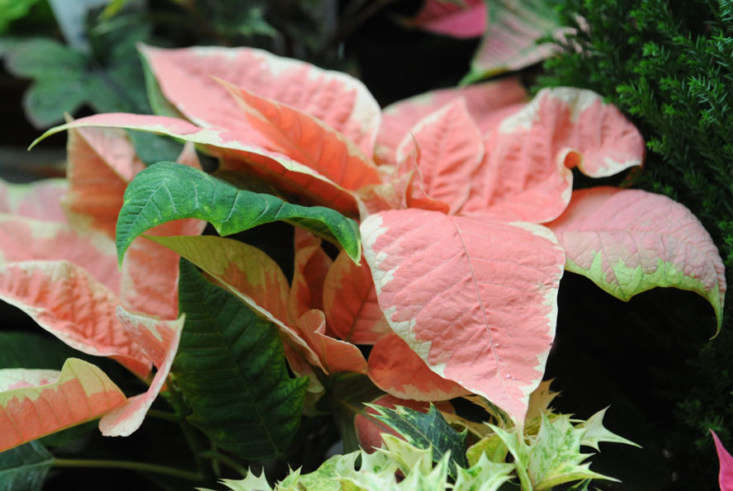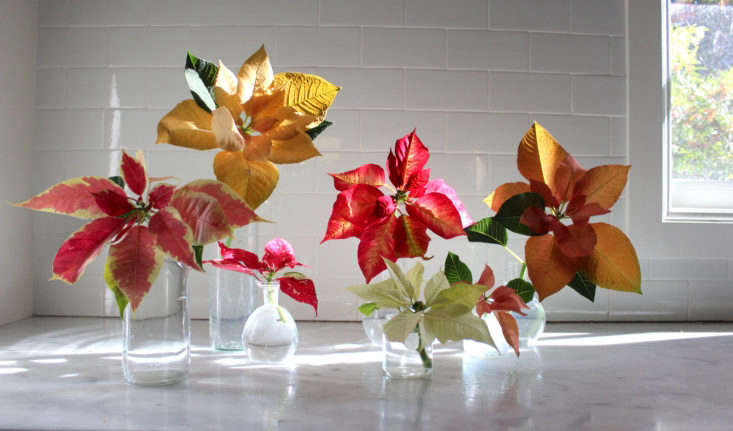Are we still dismissing the poinsettia as a seasonal Christmas cliché? If so, we have much to learn about this brilliantly colored scarlet plant (and its white, pink, yellow, and striped cousins).
Before warm-weather native Euphorbia pulcherrima came to the US in 1828 (thanks to a chance meeting with Dr. Joel Roberts, the ambassador to Mexico at the time), poinsettias were spindly shrubs. No more. Nearly two hundred years later, they’re bushy and have become the best-selling potted plant nationwide. Read on to learn about their transformation (one of the 10 things nobody tells you about poinsettias).
1. More poinsettias are sold than any other potted plant.

Nearly one of every four potted plants sold in the US is a poinsettia, according to the USDA. That adds up to 34 million poinsettias a year.
The No. 2 and No. 3 spots belong to orchids and Easter lilies, distant runners-up.
2. You can buy more than 100 varieties of poinsettia.

“There are more than 100 varieties of poinsettias available today. Poinsettias come in colors like the traditional red, white, pink, burgundy, marbled and speckled,” reports the University of Illinois Extension.
3. Poinsettias are not poisonous.

It’s a myth that poinsettias are poisonous. “This rumor has persisted for decades, possibly starting with a report from Hawaii about a fatality that happened over 75 years ago. The myth was busted after research conducted in the 1970s at Ohio State University,” writes David Grist of Gardener’s Supply.
4. Poinsettias have colorful leaves (not flower petals).

Those are colorful bracts—not petals—that are getting your attention.
5. Red is the most popular color of poinsettia.

Of the more than 34 million poinsettias sold annually in the US, according to the most recent USDA Floriculture Statistics report, 75 percent are red. (The No. 2 and No. 3 most popular colors are white and pink.)
6. You’ve probably never noticed a poinsettia’s real flower.

Look closely at the center of a poinsettia—those bead-like yellow clusters at the base of each bunch of leaves are cyathia (the real flowers of poinsettia plants).
7. Poinsettias are shrubs and can grow as big as small trees.

8. Poinsettia is the original hothouse flower.

Poinsettias hate the cold, wilt in drafts, and need moist soil. Yours will be happiest in a room where temperatures hover between 60 to 70 degrees Fahrenheit.
9. You can coax a poinsettia to bloom again next Christmas.

This is a project for someone who really loves poinsettias. To get one to bloom again next year, you need to know something about the plant’s daily routine. About 10 weeks before you want it to bloom again, restrict its exposure to sunlight to no more than 10 hours a day. The other 14 hours, consign it to a dark closet. Be strict about this, starting around October 1, and you will be able to coax it into color again by Christmas.
10. The ‘i” is not silent: pronounce it poinsett-i-a.

Read more growing tips in Poinsettias: A Field Guide to Planting Care & Design in our curated guides to Shrubs 101 and Tropical Plants 101. For more ideas about how to incorporate poinsettias into your holiday decor, see:
- Poinsettias: Rethinking a Christmas Cliché
- DIY Poinsettia: A Common Christmas Plant Goes Luxe
- An Insider’s Guide to Getting First Dibs on the Best Ikea Houseplants












Have a Question or Comment About This Post?
Join the conversation (3)